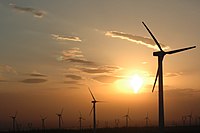
Photo from wikipedia
Abstract With the increasing use of the IoTs, the necessity of having in-situ and independent resources have become more vital. Among clean energy sources, triboelectric nanogenerators (TENGs) have been introduced… Click to show full abstract
Abstract With the increasing use of the IoTs, the necessity of having in-situ and independent resources have become more vital. Among clean energy sources, triboelectric nanogenerators (TENGs) have been introduced as a new and widely used technology in the field of renewable sources and passive self-powered sensors. In this research, a completely new model in rotational triboelectric nanogenerator (R-TENG) structures is presented in which two different modes of contact-separation and freestanding triboelectric layer are used simultaneously and leads to the generation of high power density compared to structures using a simple mode. This novel triboelectric nanogenerator has been used to build a self-powered anemometer station under the IoT network. Two triboelectric layers of PET and Kapton are used with a spacer between them. The measured open circuit voltage (VOC) and short circuit current (ISC) were about 900 Vp-p and 22 mA, respectively at 2000 rpm. Moreover, the maximum delivered power was obtained in the matching resistance of 270 kΩ, equivalent to 168 mW. The maximum power density in this R-TENG was 8.55 mW/cm2. Finally, an electronic circuit was designed and fabricated for power management, information processing and transmission. Also, special software has been developed for displaying and storing wind speed data for this application.
Journal Title: Nano Energy
Year Published: 2021
Link to full text (if available)
Share on Social Media: Sign Up to like & get
recommendations!